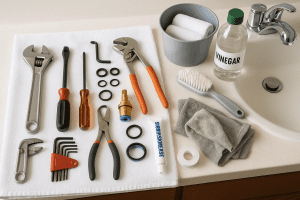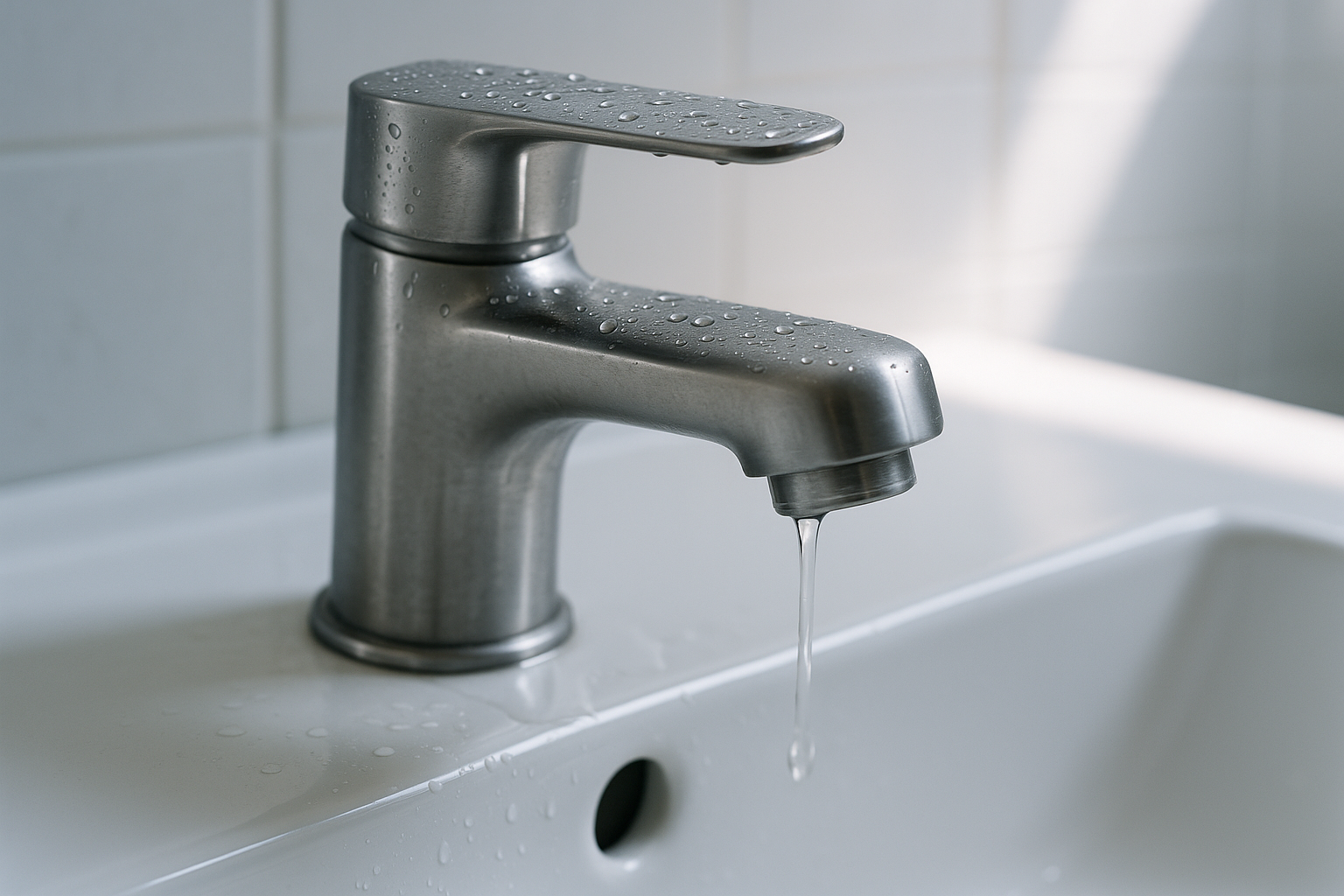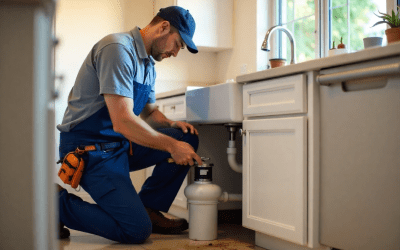A dripping or stiff bathroom sink faucet can be more than a small inconvenience; it may waste gallons of water, raise utility costs, and even cause wear on plumbing fixtures. Many of these problems are surprisingly simple to fix with the right approach. Leaks often come down to worn washers, clogged aerators, or mineral buildup inside the faucet. Loose handles and faulty cartridges are also common culprits that can be resolved without replacing the entire unit.
In this professional guide, you’ll learn how to identify the source of common faucet troubles and carry out straightforward faucet repairs. With clear steps and expert tips, tackling a bathroom sink faucet issue can be both manageable and cost-effective.
Tools and Materials You’ll Need Before Starting

Before attempting to repair a bathroom sink faucet, gathering the right tools and supplies will save time and reduce the risk of mistakes. Most faucet repairs require only a few basic items:
- Adjustable wrench or basin wrench – Essential for loosening and tightening nuts in tight spaces beneath the sink.
- Screwdrivers (phillips and flathead) – Used to remove handles, escutcheons, and other small components.
- Allen wrench (hex key set) – Many modern faucets use set screws that require hex keys for disassembly.
- Pliers (slip-joint or needle-nose) – Helpful for gripping and pulling out cartridges, washers, or aerators.
- Replacement parts – This may include washers, O-rings, faucet cartridges, or aerators, depending on the issue.
- Plumber’s grease – Ensures smooth movement of internal parts and prevents premature wear.
- Plumber’s tape (Teflon tape) – Creates watertight seals on threaded connections.
- Bucket and towels – Catch water drips and protect the cabinet from damage.
- Cleaning supplies (vinegar, brush, or rag) – Useful for clearing mineral deposits and cleaning faucet parts before reassembly.
Common Bathroom Faucet Problems & Step-by-Step Guide to Fix Them
Bathroom faucets typically fail due to wear, mineral buildup, or loose components. Below are the most common problems and practical bathroom sink faucet repair steps:
Dripping or Leaking Faucet
Key Reasons
- Worn washers (common in compression faucets where the washer presses against the valve seat).
- Damaged or dry O-rings, leading to poor seals inside the faucet.
- Faulty or deteriorated cartridge in cartridge-style faucets.
- Corrosion of the valve seat, which prevents a watertight seal.
Fixes
- Shut off the water supply under the sink.
- Remove the faucet handle using a screwdriver or hex key.
- Take out the cartridge, washer, or O-ring, depending on the faucet type.
- Inspect parts for cracks, flattening, or wear; replace with identical parts (manufacturer’s manual helps here).
- Clean the valve seat with vinegar or a non-abrasive brush if corroded.
- Reassemble, turn the water back on, and test for drips.
Low Water Pressure
Key Reasons
- Clogged aerator due to sediment or mineral buildup.
- Blocked cartridge restricting flow.
- Partially closed shut-off valves under the sink.
- Household plumbing issues or high sediment in supply lines.
Fixes
- Unscrew the aerator at the spout tip and rinse out debris.
- Soak the aerator in vinegar for 30–60 minutes to dissolve mineral buildup.
- Inspect the faucet cartridge; if water flow is still weak, remove and clean or replace it.
- Ensure both hot and cold shut-off valves are fully open.
- If low pressure continues, flush supply lines or consult a plumber in Schertz or Cibolo for possible pipe obstructions.
Water Leaking at the Base
Key Reasons
- Deteriorated or cracked O-rings around the spout base (leading cause calling for faucet repair).
- Loose mounting hardware under the sink.
- Worn seals inside the faucet body.
Fixes
- Shut off the water supply.
- Remove the faucet handle and lift off the spout.
- Inspect and replace worn O-rings with matching replacements.
- Apply plumber’s grease to the new O-rings before reinstalling.
- Tighten mounting hardware beneath the sink.
- Reassemble, turn the water back on, and check for leaks.
Faucet Doesn’t Shut Off Completely
Key Reasons
- Damaged or worn-out cartridge (single-handle faucets).
- Broken washer or seat in compression faucets.
- Mineral deposits preventing a tight seal.
Fixes
- Turn off the water supply and remove the faucet handle.
- Replace the faulty cartridge, washer, or seat washer.
- Clean all internal parts of mineral buildup with vinegar.
- Reassemble and confirm complete shutoff.
Inconsistent Water Temperature
Key Reasons
- Malfunctioning mixing cartridge (common in single-handle faucets).
- Blockage in hot or cold supply lines.
- Faulty water heater or inconsistent supply pressure.
Fixes
- Check supply valves to ensure both hot and cold water are fully open.
- Inspect and replace the mixing cartridge if worn or clogged.
- Flush supply lines to remove debris or sediment.
- If the issue persists, test the water heater for performance problems or consult a plumber in Cibolo or Schertz.
Stiff or Hard-to-Turn Handle
Key Reasons
- Mineral deposits around the cartridge or stem.
- Dry or deteriorated O-rings.
- Rust or corrosion in older faucets.
Fixes
- Shut off the water and remove the handle before carrying out bathroom sink faucet repair.
- Clean the cartridge or stem with vinegar to dissolve buildup.
- Apply plumber’s grease to moving parts and O-rings.
- Replace the cartridge or handle if cleaning doesn’t restore smooth movement.
Loose or Wobbly Handles
Key reasons
- Loose set screw holding the handle to the stem.
- Stripped threads or worn handle splines that no longer grip securely.
- Excessive wear in the cartridge stem itself.
Fix
- Remove the decorative cap to reveal the set screw.
- Tighten the screw with a screwdriver or hex key.
- If tightening doesn’t fix the wobble, inspect the handle splines for wear.
- Replace the handle if it no longer fits snugly.
- For older faucets, replacing the cartridge may be necessary if the stem itself is worn.
Noisy Faucet (Whistling or Screeching)
Key reasons
- Loose or vibrating washers are causing noise as water flows past.
- Worn cartridge restricting smooth water passage.
- Excessive water pressure (above 60 psi) leading to vibrations.
- Partially closed shut-off valve creating turbulence.
Fix
- Inspect washers and cartridges; replace if worn or damaged.
- Check that shut-off valves are fully open.
- Test household water pressure with a gauge (attach to an outdoor spigot or supply line).
> Ideal residential pressure: 40–60 psi.
> If above 80 psi, install or adjust a pressure-reducing valve (PRV). - If noise persists, inspect supply lines for loose fittings or kinks.
Corrosion or Rust on Faucet Parts
Key reasons
- Prolonged exposure to hard water and mineral deposits.
- Worn protective coating on metal finishes.
- Moisture trapped under faucet seals.
Fix
- Remove rust with a soft brush and vinegar solution.
- Replace heavily corroded washers, O-rings, or cartridges.
- Apply plumber’s grease during reassembly to slow future corrosion.
- For exterior rust on finish, use non-abrasive cleaners only.
Persistent Mold or Mildew Around Faucet Base
Key reasons
- Continuous moisture from small leaks.
- Poor ventilation in the bathroom.
- Deteriorated caulking around the base.
Fix
- Dry the area thoroughly and clean with a mild bleach solution.
- Inspect and replace O-rings or seals to stop leaks.
- Reseal around the faucet base with waterproof bathroom-grade silicone.
- Improve bathroom ventilation to prevent recurrence.
Conclusion
Tackling bathroom faucet problems on your own can be rewarding, but not every issue is as straightforward as it seems. Hidden leaks, corroded parts, or persistent pressure problems may require specialized tools and training to repair correctly. That’s where Local Plumbing LLC stands out. Our team specializes in faucet repair, ensuring accurate diagnosis and lasting solutions that protect your home from water waste and damage. When simple fixes aren’t enough, choosing us means reliable service, expert care, and peace of mind for your bathroom plumbing needs. Call us at (210) 978-3995 for the best plumbing repair solutions in Schertz, TX, and the surrounding areas.




